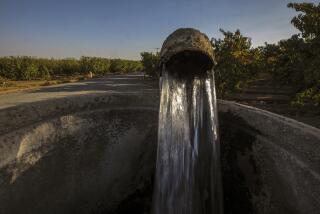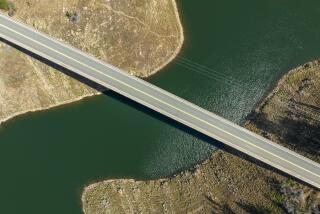When Saying ‘It’s Over’ Is Hard to Do
- Share via
SACRAMENTO — It has gotten so bad they can’t keep up the pretense any longer. Houses have been sliding down cliffs. Subdivisions have flooded, cars buried in mud, Sierra highways closed by avalanches. People have drowned.
At the front door of California’s capital, the Sacramento River--lifeblood of the State Water Project--has been barreling at a nasty clip, 12 feet higher than normal, hellbent for the Golden Gate with a booty of trees, docks and farm animals.
State officials tell us that as of Jan. 31--even before this latest series of torrential rains and blizzards--precipitation statewide was 155% of average for the date, and the snowpack 175%.
But the officials have been reluctant to utter the dreaded O-word--as in “it’s over ,” the drought--and candidly acknowledge what every citizen already sees, feels and knows. This drought has been over for weeks, if not months. Only in the last few days have some bureaucrats, to the distress of the state’s top administrators, begun fessing up.
“I think it is over,” has been a typical pronouncement, or: “ Essentially , the drought is over” or “As far as precipitation goes, yes. . . .”
And what other kind of drought is there except a drought of precipitation, one might ask. Such a person would not understand the government mind, which realizes that public policy often can be shaped--and political agendas achieved--by playing fast and loose with the English language. Thus a tax increase can be called a “loophole closing” or--in President Clinton’s case with Social Security--a “spending cut.” Increased spending is an “investment.”
And unfilled reservoirs and depleted aqueducts--a man-made water shortage-- is a “drought,” no matter how much precipitation nature is providing.
*
By government’s definition, California better get ready for incessant drought. The state’s present water system was designed more than 30 years ago when its population was half what it is now. The population is expected to grow by another third over the next 15 years and the state still has not decided how to provide all the necessary water.
Will it come from agriculture, which uses more than 80% of California’s developed water? Yes, probably much of it. Will it come from further devastation of fish and wildlife? Perhaps not; environmentalists now are on a roll. Will it come at the expense of urban development? Probably not; too much economic wealth is at stake. From individual conservation? A drop in the bucket, given human nature.
Will the increased water be supplied by new facilities--reservoirs, canals, pumps? That is likely. But first the historic warring factions--urban/business interests, farmers and environmentalists--must reach a political consensus. Or, alternatively, two of the three must align so strongly that they can roll roughshod over the third party.
This is what happened in Washington last fall when two traditional archenemies, the urbanites and the environmentalists, teamed up to rout agriculture in enacting a landmark bill sponsored by Rep. George Miller (D-Martinez). That measure diverts huge amounts of federal water from agriculture to the environment and allows individual farmers to sell water to cities.
Environmentalists recently won another victory--at the expense of agriculture and urbanites--when the State Water Resources Control Board announced plans to sharply reduce water exports from the Sacramento-San Joaquin Delta. It also proposed a $300-million environmental fund to be financed by new water fees.
Environmentalists scored again last week when the Marine Fisheries Service ordered a curtailment in delta pumping of water south into the Central Valley and Southern California. The pumps have been chewing up endangered young winter-run salmon.
*
No sane person enjoys a drought. But in truth the rival water factions and state government have just been through a six-year love-hate relationship with California’s drought and, in their heart of hearts, can’t bear to say “it’s over.”
The drought has forced water districts and citizens to conserve. It also has pressured the warring interests into various negotiations aimed at reaching long-term solutions such as better delta plumbing, increased Central Valley storage, profitable water transfers and more environmental protection. But time ran out--the drought’s over--and they’re still plodding along.
Gov. Pete Wilson used the O-word Wednesday, thus halting any further corruption of the English language and erosion of government credibility. He announced that the State Drought Center is being turned into a Water Conservation Center. He might consider making it a Flood Emergency Center.
More to Read
Sign up for Essential California
The most important California stories and recommendations in your inbox every morning.
You may occasionally receive promotional content from the Los Angeles Times.













